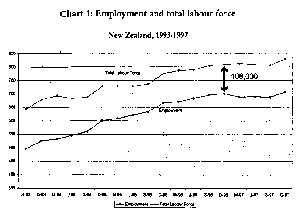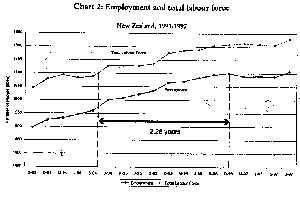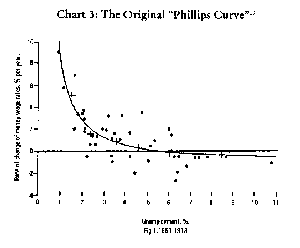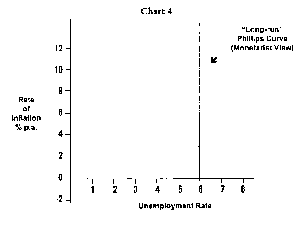
-
Monetary Policy and Employment
- EMPLOYMENT AND INFLATION IN ECONOMIC THEORY
The reason why the Reserve Bank (and others who share its views around the world) manages the economy so as to retain a substantial pool of unemployed is that it fears that full employment would be inflationary, i.e. that as the economy approached full employment, wages and prices would start to increase rapidly and we would soon be back to double-digit inflation. The idea of there being a functional link between unemployment and inflation is usually attributed to the work of A.W. Phillips in the 1950s. Phillips studied fifty years' wage and unemployment data in the United Kingdom and found that he could plot a curve that looked like this:
Click on chart for large view
Ever since, this has been known as the "Phillips Curve" and it has become one of the seminal ideas of modem economics. The shape of the curve implies that as an economy approaches full employment, wages (and prices) have a tendency to rise quite fast, whereas in conditions of high unemployment, wages (and prices) will stabilise, or fall slightly. This led to the idea, in the 1950s and 1960s, that policy makers could choose a combination of inflation and unemployment according to their political-econornic preferences. For example, that they could choose to have 4-5% unemployment with stable prices, or 1-2% unemployment with an inflation rate of 4-5%. In practice, the relationship was not as deterministic as this. As can be seen from the wide dispersion of the individual observations for unemployment rates between 2% and 7%, even the original Phillips Curve suggested that there could be considerable variation in inflation-unemployment outcomes.While the statistical suggestion of an inflation-unemployment relationship in the UK is correctly attributed to Phillips, the idea that such a relationship existed was firmly held by economists and policy advisers of the World War H era. For example, Keynes, in his 1936 General Theory, pointed to a number of cost pressures which were likely to appear as an economy approached full employment, and a large section of the 1944 Beveridge Report (which laid the foundations for the UK's post-war full employment policy) was devoted to practical ways of avoiding cost-driven inflation. Policy makers in New Zealand were also aware of the issues, and designed a system to avoid inflation. The principal institutional arrangements were the Arbitration Court system of wage-setting, careful management of government spending and the regulation of the banking system (to prevent inflationary expansion of the money supply). Other countries adopted variants of their own; for example, the "Rehn-Meidner" system in Sweden, which rested on disciplined fiscal policy, centralised wage bargaining and active labour market policies.
As a result, the Phillips curve did not fit New Zealand's inflation-unemployment experience in the 1950s and 1960s. During that period, we had completely full employment ("over-full" employment, some economists used to say) but an inflation rate mostly in the 2-6% band. If the Phillips curve were literally true for New Zealand, we should have had an exponential increase in inflation as we approached the zero unemployment level. So clearly there is room for a country to achieve a result which is offthe Phillips curve, providing this is facilitated by the appropriate economic behaviour and institutional arrangements.
Those countries which saw themselves as operating on a Phillips curve (such as the USA and the UK) found that the observed statistical relationship started to break down in the late 1960s, and vanished altogether in the 1970s. Inflation surged even as the economic growth rate fell, leading to what is known as "stagflation". In retrospect, a number of reasons for the increase in the inflation rate can be discerned. These were: the inflationary financing of the Vietnam war by the US government, the post-1968 wage explosion (for example, during the 1968 Paris insurrection, De Gaulle offered a 10% wage increase), increased deficit financing of government expenditure, accommodating monetary policy and the OPEC oil price rises. In other words, in many countries there was a breakdown in social consensus over income distribution and a general loss of economic discipline.
While an historian or a sociologist might ascribe these events to the foibles of human nature and recommend the restoration of a policy consensus as the obvious solution, the response of some in the economics profession was more punitive. The so-called "monetarist" school of economics, led by Milton Friedman, rose to dominance and the Keynesians were eclipsed. According to the monetarists, the elimination of inflation was the most important economic goal, and an essential precondition was the recognition that economies could not operate indefinitely at full or near-full employment. Instead, policy-makers should aim to achieve only the "natural" rate of unemployment, which they suggested was around 6% of the workforce. The "natural" rate of unemployment is also known as the "non- accelerating inflation rate of unemployment", or NAIRU. Relating his ideas to the Phillips curve, Friedman suggested that the "true" Phillips curve was a long-run curve, which was not convex such as that drawn by Phillips, but vertical at the NAIRU,as shown in Chart 4.
Click on chart for large view
According to the monetarists, any attempt to push unemployment below this "natural" rate would simply result in increased inflation, which would reduce the real level of demand in the economy and push the unemployment rate back up to the "natural" rate. Since it could not reduce the unemployment rate in the long term, and only led to more inflation, no attempt to push unemployment below its "natural" rate should be made.While many Keynesian, and other non-monetarist, economists dissent from this bleak theory, it has been the dominant view of the relationship between unemployment and inflation since the late 1970s, underlying the deflationary policies of the US central bank and the UK Thatcher government in the early 1980s. In New Zealand, since 1984, the Treasury and the Reserve Bank have subscribed to this theory", and New Zealand cabinet ministers (Labour, National and New Zealand First) have either actively supported it, or acceded to it. Hence New Zealand's experience in the 1990s has been that, while the Reserve Bank allowed unemployment to fall from 11% to 6-7%, it has prevented any reduction below 6%, by raising interest rates and the value of the dollar and slowing down the economy. When Treasury did its modeling work on the Retirement Savings Scheme for the 1997 Referendum, it assumed an unemployment rate of 6% right through to the year 2050!
This points to an extraordinary contradiction at the heart of government policy, for initiatives such as "work for the dole" and the "code of social responsibility" suggest that it is the fault of the unemployed that they are out of work. However, if the economy were to somehow grow enough to absorb the unemployed, the Reserve Bank, wanting to avoid any outbreak of inflation, would immediately raise interest rates to slow the economy down, and unemployment would rise again. Under current policy, New Zealand is condemned to having a large, permanent pool of unemployed people.
We do not accept this, nor, we believe, does a majority of New Zealanders. Most people would prefer to have an economy with full employment, or, at least, a level of employment close to full employment. Is this possible, or would it simply set off another burst of high inflation?
There are three pieces of evidence which should encourage us to take the risk of moving the economy towards full employment.
Firstly, the shape of the original Phillips curve, which was seen as being a reasonably accurate description of reality in market economies such as the USA and the UK in the 1950s and 1960s. The curve has a convex shape, i.e. it is bowed in towards the origin of the graph." This means that, as unemployment falls, there is little initial impact on prices. If inflation increases, it only does so as unemployment drops to very low levels.
Secondly, New Zealand managed to get itself off the Phillips curve altogether for a long period of time - from the 1940s to the late 1960s. We managed to combine completely full employment with a moderate, and socially acceptable, rate of inflation. If we could do it once, why can't we do it again?
Thirdly, the 1990s have seen worldwide inflation drop to extremely low levels, even in countries with low unemployment. The USA, which used to have a higher rate of unemployment than other countries, has managed to get its unemployment rate down to under 5% without an outbreak of inflation. This shows, at the very least, that a NAIRU of 6% is not set in stone. Even for a conservative central bank, there should be some room for downside experimentation.
How should we go about it?
During the next expansion phase of the economic cycle, the government and the Reserve Bank should allow the economy to expand enough to take the unemployment rate below the 6% level and to gradually move it down past the 5% and 4% levels. A good intermediate target would be a 3% unemployment rate. If that can be achieved without a burst of inflation, then a further reduction should be managed. Providing it is not done too fast, and there is time for capital investment, for attracting people who have dropped out of the labour force back into it, and appropriate institutional adjustments (e.g. to the workplace training system), it should be possible to arrive at a close approach to full employment, without encountering run-away inflation.
Source -- "From Towards a New Monetary Policy" by David Steele and John Lepper published by the Alliance, July 1998

Top of Page
This Letter's Main Page
Stats | Subscribe | Index |
The Jobs Letter Home Page | The Website Home Page
jrt@jobsletter.org.nz
The Jobs Research Trust -- a not-for-profit Charitable Trust
constituted in 1994
We publish The Jobs Letter
The Alliance takes on the Reserve Bank and its effect on jobs
By David Steele and John Lepper
from their paper "Towards a New Monetary Policy" (pub Alliance 1998)
According to the Reserve Bank, its anti-inflation policies do not have any adverse effect on employment:
"Ideally monetary policy aimed at price stability results in economic activity close to its sustainable maximum at all times, with no costs to employment at all. This is what we strive for. " -- Dr Don BrashPutting aside the use of the word "ideally" (which may have brought an ironic smile to the face of the reader), what does this statement actually mean? What is implied by the phrase "sustainable maximum"? Does it mean that the economy should function at full employment, or at some other level?
Chart 1 shows the Number of People Employed in New Zealand (March 1994 to December 1997) compared with the Total Labour Force.
Click on chart for large view
There are two ways of looking at these curves. The first (the usual way) is to look at the vertical distance between the curves, which represents the number of "official" unemployed. During 1994 the number of unemployed and the rate of unemployment decreased (this can be seen in the narrowing of the gap between the two curves), but since then the two curves have proceeded roughly in parallel. In December 1996, unemployment was at its recent low point of 108,000, and the rate of unemployment was 6%.
However, there is a second way of looking at the two curves, which is to look at the horizontal distance between them, that is the gap in time between Employment and Total Labour Force. This is shown in Chart 2 below.
Click on chart for large view
From this chart it can be seen that Employment in December 1996 was equal to the Total Labour Force of September 1994. In other words, Employment was trailing the growth of the Labour Force by two and a quarter years. Or, putting it another way, if we could have had the December 1996 Employment level in September 1994, we would have had full employment in New Zealand.
This puts a different perspective on New Zealand's unemployment problem and shows that it is not as inevitable or intractable as people sometimes feel. In September 1994, the Total Labour Force was 1.7 million people. It cannot be considered impossible to have provided 1.7 million jobs, because only two and a quarter years later - in December 1996 - the economy was providing 1.7 million jobs. There is nothing magic about the numbers. They contain no inherent barrier.
If we wish to achieve full employment, then, the answer is to allow the economy to grow slightly faster for a few years until the Employment curve catches up with the Total Labour Force curve. Once this point is reached, the rate of economic growth can be eased back until the Employment growth rate matches the Labour Force growth rate. The growth rate after the transition would be just the same as it was before the transition, but the economy would be proceeding at full employment, rather than with a large pool of unemployed.
There are certain ancillary effects which would have to be taken into account (e.g. the effect of a growing economy on immigration, productivity, etc.) but these do not alter the basic principles involved.
The above approach has a common sense ring to it, and would probably be supported by most New Zealanders. So why don't we do it? Is there something accidental or inevitable about our current level of unemployment, or is it the result of a deliberate policy decision?
Unfortunately, the latter is the case. After 1984, the Wellington economic policy establishment abandoned the goal of full employment in order to prioritise other objectives such as fighting inflation, privatising, state assets and cutting taxes. The goal of full employment wasn't only abandoned in a practical sense, but tbeoretically as well, in favour of the competing doctrine of the "natural rate of unemployment", a doctrine which is closely bound up with the Reserve Bank's regulation of the economy. To understand this point, a small journey into the recent history of economic thinking is required.












